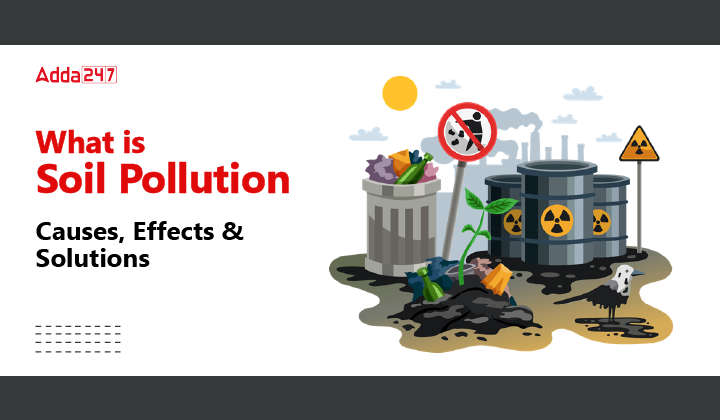Table of Contents
Soil pollution occurs when the soil contains abnormally high concentrations of harmful chemicals or compounds, disrupting its natural composition and fertility. This contamination can result from industrial waste, excessive use of chemical fertilizers and pesticides, oil spills, or improper disposal of household and electronic waste. Soil pollution poses serious threats to human health, agriculture, and ecosystems, as it can lead to reduced crop yields, contamination of food chains, and groundwater pollution.
For candidates preparing for government teaching exams, understanding soil pollution is crucial, especially for environmental studies and geography sections. Key areas to focus on include the sources and types of soil pollutants, their effects on health and the environment, and mitigation strategies such as proper waste management, organic farming, soil remediation techniques, and regulatory measures. A thorough grasp of these concepts will enable aspirants to answer related questions accurately and demonstrate a strong command of environmental issues.
What is Soil Pollution – Definition
It is crucial to know that all soils include substances that are hazardous or detrimental to humans and other living things. However, because of their low quantity in unpolluted soil, these compounds do not endanger the local environment. The soil is considered contaminated when the concentration of one or more of these harmful compounds is high enough to harm living things.
The root cause of soil pollution is usually one of the following:
- Agriculture (high/improper use of pesticides)
- Enormous industrial activity
- Poor management or inefficient disposal of waste
The magnitude of soil pollution directly affects the difficulties involved in decontaminating the soil. The more contaminated an area is, the more resources are needed for cleanup.
Soil Pollution – Causes
Xenobiotics, or chemicals created by humans rather than occurring naturally in nature, are among the most dangerous soil contaminants. Greek words ‘Xenos’ (foreigner) and ‘Bios’ (life) are the origins of the word ‘xenobiotic’. Several xenobiotics are known to cause cancer.
The pollution can be categorized into two parts- Pollution caused by natural elements and Anthropogenic soil pollution (this is caused by human activity). In the following section, we will discuss both the natural and anthropogenic soil pollution in detail.
Natural Soil Pollution
Some contaminants naturally accumulate in soils in some incredibly rare ways. This might happen because soil is deposited differently by the atmosphere. Another way that this kind of soil contamination might happen is when:
- Chemicals are carried by the water from precipitation.
- The buildup of substances with the perchlorate anion (ClO4-) in some dry, arid habitats is an example of natural soil pollution.
- Depending on the effects of the environment, some pollutants can naturally occur in the soil.
- For instance, perchlorates can occur during a thunderstorm in soils that contain metals and chlorine.
Anthropogenic Soil
Most of the cases of soil pollution are anthropogenic in nature. A variety of human activities can lead to the contamination of soil. Some such processes are listed below.
- The contamination of adjacent soil with asbestos during the demolition of historic structures is a possibility.
- Lead-based paint usage during building activities has the potential to contaminate the soil with dangerous levels of lead.
- The hydrocarbons in petroleum can pollute soils when petrol and diesel spill during transportation.
- The dispersion of metallic pollutants into the neighbouring soils is frequently a result of activities connected to metal-casting plants (foundries).
- Land can get contaminated with heavy metals as a result of underground mining operations.
- Highly toxic industrial and chemical waste that is improperly disposed of can seriously damage the earth. For instance, the disposal of hazardous material in landfills may cause soil contamination. Groundwater may also become contaminated by this garbage.
- Chemical pesticides include a number of dangerous ingredients.
Soil Pollution – Effects
A wide range of unfavourable effects caused by soil pollution harm humans, animals, plants, and the environment as a whole. Children are more vulnerable to diseases, so polluted soil is more dangerous to them. This subsection goes into detail about several significant implications of soil pollution.
Effects on Human Beings
There are certain short-term and long effects of human exposure to polluted soil. In the following table, candidates will find a detailed description of all the short-term and long-term Effects of Soil Pollution on Human Beings.
| Effects of Soil Pollution on Human Beings | |
| Short Term Effects | Long Term Effects |
|
|
Effects on the Biodiversity
Through a process called bioaccumulation, plants grown in polluted soil may collect significant amounts of soil pollutants.
- All the accumulated pollutants are transferred up the food chain when herbivores eat these plants.
- This may cause numerous beneficial animal species to disappear or go extinct.
- Additionally, these toxins have the potential to ascend the food chain and eventually appear as diseases in people.
Effects on the Ecosystem
A clear link between soil pollution and air and water pollution exists because volatile chemicals in soil can be blown into the sky by winds or seep into subsurface water reservoirs.
- Additionally, it can cause acid rain by releasing a significant amount of ammonia into the environment.
- Several microorganisms that enhance soil texture and help in the breakdown of organic materials are hostile to acidic soils.
- The detrimental impacts of soil contamination also affect the texture and quality of the soil.
Soil Pollution – Solutions
In order to deal with soil pollution, several technologies have been created. The following is a list of some solutions used to clean up polluted soil.
- Polluted soils are dug up and then transported to far-off, unpopulated areas. Thermal remediation is used to remove pollutants by forcing them into the vapour phase, where they can then be collected via a process called vapour extraction.
- Plants and microorganisms are used in bioremediation and phytoremediation to clean up contaminated soil.
- Fungi are used in mycoremediation to help heavy metal pollutants build up.
Soil pollution refers to the contamination of the Earth’s soil with harmful substances, adversely affecting its natural fertility, composition, and biodiversity. Human activities such as industrial waste disposal, agriculture, mining, and the use of agrochemicals have been major contributors to soil pollution.
Toxic chemicals, heavy metals, pesticides, and improper waste management practices seep into the soil, posing significant risks to both environmental and human health. Mitigating soil pollution requires adopting sustainable agricultural practices, promoting proper waste disposal, and implementing stringent environmental regulations to safeguard this vital resource and ensure a healthier and sustainable future.
Download UGC NET Paper 1 Study Notes PDF
The direct link to download UGC NET Paper 1 Study Notes PDF has been given below. Candidate can read and download the What is Soil Pollution – Causes, effects and Solutions Study Notes PDF.
Download What is Soil Pollution – Causes, Effects and Solutions Study Notes PDF
| UGC NET Study Notes Important Links | |
| UGC NET Study Notes for Paper 1 | UGC NET English Literature Notes |
| UGC NET Commerce Notes | |




 UGC NET Teaching Aptitude Questions Answ...
UGC NET Teaching Aptitude Questions Answ...
 UGC NET Philosophy Syllabus 2025 PDF Dow...
UGC NET Philosophy Syllabus 2025 PDF Dow...
 UGC NET Commerce Syllabus 2025 PDF Downl...
UGC NET Commerce Syllabus 2025 PDF Downl...












